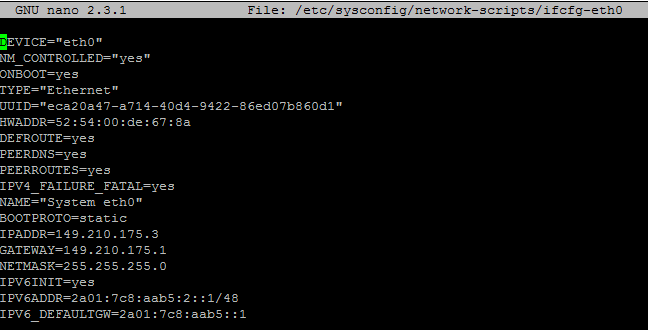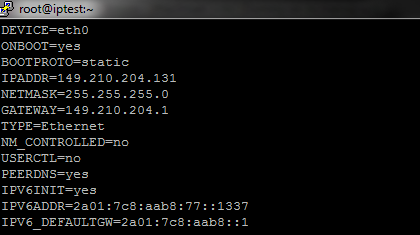When you order an extra IPv4 address or add an extra IPv6 address to your IP addresses via the TransIP control panel, these cannot be automatically added to your VPS via DHCP. Additional IP addresses are added manually to the network interfaces.
In this article, we explain how you can statically add an extra IPv4 or IPv6 address to your CentOS 7 VPS. For this, an extra IPv4 and/or IPv6 address is required (depending on which you'd like to add / configure). Don't have an extra address yet? The following articles explain how you can get one:
- Ordering an extra IPv4 address in the control panel
- Creating an extra IPv6 address in the control panel
Click here for a complete overview of all our tutorials for adding an extra or static IPv4 or IPv6 address to various Linux distros. For adding an IPv4 or IPv6 address to a Windows VPS, see this article.
- This manual is about public IP addresses. In this manual, you will find more information about setting up internal addresses (for your private network).
- A VPS includes 1 IPv4 address by default, but you can expand this to a maximum of 20 IPv4 addresses.
- Each VPS has a /64 IPv6 range at its disposal by default, where IP addresses can be added as desired. A /64 IPv6 range contains a total of 18,446,744,073,709,551,616 IP addresses, so the likeliness that you will not have enough is quite small! The default gateway falls outside of the /64 range so as netmask you always use a /48 range.
Adding an IPv4 address in CentOS 7
Step 1
Connect to the VPS via the VPS console or via SSH.
Step 2
Once logged in you see the current network interfaces and the set IPs by means of the command:
ifconfig -a
For the next steps, it is especially important that you are aware of the correct adapter name. Which is eth0 in this example.

Step 3
Please note: Did you use our fast installs feature for VPS and chose for installation via SSH-keys, one time password, or cloud-config user data? Then, additional steps are required. Click 'Fast installs proces' below to view these steps.
nano /etc/cloud/cloud.cfg.d/99-disable-network-config.cfgnetwork:
config: disabledtouch /etc/cloud/cloud-init.disableddpkg-reconfigure cloud-initNow add the extra IPv4 address in the network interfaces. First, open the network configuration file:
nano /etc/sysconfig/network-scripts/ifcfg-eth0
Please note: In CentOS 6 an extra interface had to be created for each individual IP address, such as eth0:1, eth0:2, etc. In CentOS 7 this is no longer necessary.

The existing configuration file opens and you add the following:
IPADDR0=149.210.175.3 IPADDR1=149.210.193.224 IPADDR2=149.210.193.225 NETMASK0=255.255.255.0 NETMASK1=255.255.255.0 NETMASK2=255.255.255.0 GATEWAY0=149.210.175.1 GATEWAY1=149.210.193.1 GATEWAY2=149.210.193.1
IPADDR(x) is the IP address that you want to set and GATEWAY(x) the gateway, which for your IP address can be found in the control panel.
For every IP address that you add, you use an ascending number, i.e. IPADDR0, IPADDR1, IPADDR2, IPADDR3, etc. The same applies to gateways if applicable. You need to leave the (sub)NETMASK at 255.255.255.0.
Save the changes and exit nano (ctrl + x > y > enter).
Step 4
Reset your network interfaces with the following command to use the new IP address:
systemctl restart network
Step 5
If you run ifconfig -a or ip addr again you will see the newly added IPv4 address. You can test this IP address by performing a ping test from another computer / IP.

Repeat the above steps if you want to add more IP addresses. In addition, it is not mandatory to add the gateway if the extra IP address is in the same /24 range. If this is not the case then you will have to add this, because otherwise, you will have trouble reaching other IPs within the TransIP network.
Adding an IPv6 address in CentOS 7
Step 1
Connect to the VPS via the VPS console or via SSH.
Step 2
Once logged in you see the current network interfaces and the set IPs by means of the command:
ifconfig -aFor the next steps, it is especially important that you are aware of the correct adapter name. Which is eth0 in this example.

Step 3
Please note: Did you use our fast installs feature for VPS and chose for installation via SSH-keys, one time password, or cloud-config user data? Then, additional steps are required. Click 'Fast installs proces' below to view these steps.
nano /etc/cloud/cloud.cfg.d/99-disable-network-config.cfgnetwork:
config: disabledtouch /etc/cloud/cloud-init.disableddpkg-reconfigure cloud-initNow add the extra IPv6 address in the network interfaces. First, open the network configuration file:
nano /etc/sysconfig/network-scripts/ifcfg-eth0
You will see an output that looks like the screenshot below.

In the opened configuration file, add the following lines if they are missing:
IPV6INIT=yes IPV6ADDR=2a01:7c8:aab8:77::1337 IPV6_DEFAULTGW=2a01:7c8:aab8::1
Save the changes and exit nano (ctrl + x > y > enter).
If you want to add more IPv6 addresses, add the following line:
IPV6ADDR_SECONDARIES="2a01:7c8:aab8:77::1338 2a01:7c8:aab8:77::1339" (etc.)
Step 4
Reset your network interfaces with the following command to use the new IP address:
systemctl restart networkIf you run ifconfig -a or ip addr again you will see the newly added IPv6 address. You can test this IP address by performing a ping test from another computer / IP.
Repeat the above steps if you want to add more IP addresses.
This concludes our tutorial on adding (static) IPv4 and IPv6 addresses to CentOS 7.




